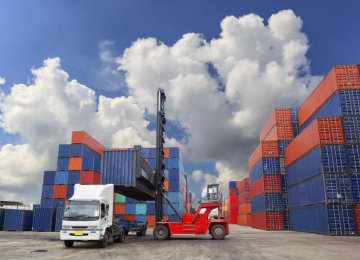Falling imports and exports in the first quarter of the current Iranian year (started March 21) have raised concerns, especially after the upward trend in Iran’s foreign trade over the past few years.
An article in the Persian daily Tejarat-e Farda reviewed the reasons behind the declining value of Iran’s international trade this year.
During 2006-10, Iran’s trade registered eye-catching average annual increases of 20%. Later, however, there were two years of decline in 2011 and 2012 due to a deep recession. But after President Hassan Rouhani took office in 2012, the economy gradually got back on its feet.
Accordingly, foreign trade picked up in 2013 and 2014. The upward trend was expected by many experts to not only continue in 2015, but to record new highs as a nuclear deal reached in July between Tehran and the world powers paved the way for western sanctions to unwind. However, the forecasts did not materialize.
In the spring, both imports and exports declined. Exports held a smaller share in the Q1 trade decline, resulting in a positive trade balance. The surplus, however, turned into a deficit in the Persian month of Mordad–the fifth Iranian month.
In the first five months of the current Iranian year, non-oil exports fell 7.32% in volume and 15.72% in value compared to the similar period of a year before.
Drop in Oil Prices
The decline in trade amid record low global oil prices, according to many experts, is no coincidence. But how could oil prices affect the trade of non-oil commodities to such a considerable extent?
The answer should be sought in the grouping of commodities that account for a sizable portion of non-oil exports. In fact, many commodities categorized by the government as ‘non-oil goods’ are derived from oil.
According to data provided by Iran Customs Administration, more than 60% are associated with various types of mineral oils and mineral fuels and their products, along with cement, waxes, petrochemicals and plastics (See Table 1).
Accordingly, fluctuations in the price of oil, which is a raw material for these products, easily impact exports. The ICA figures show that around 83% of the drop in exports are due to the global decline in the value of gas condensates and petrochemicals (See Table 2).
China’s Recession
In the past few years, China has been a popular destination for Iranian exporters. Nevertheless, China’s international trade has been on a slide.
The 13.8% drop in China’s imports from January to August is attributed mostly to declining demand for construction materials, which account for a majority of Iran’s exports to the East Asian country.
ICA figures show Tehran’s exports to China in the first five months of the current Iranian year fell 21% in volume and 23% in value compared with the similar period of last year. Considering that Beijing accounts for 35% of Iran’s exports, declining bilateral transactions hit Iran’s overall trade by around 20%.
Furthermore, recession in China’s construction sector has led to a global slide in the prices of products such as iron ore. The product, accounting for 3% of Iran’s non-oil exports—excluding gas condensates and petrochemicals, is a leading Iranian export commodity that has recorded a drop of 25% in value.
Many other commodities such as steel, zinc and copper have also seen a global drop in prices, due mostly to China’s recession. Those metals also have a considerable share in Iran’s exports.
The drop in metal prices, apart from hitting exports directly in terms of value, also reduce exports in terms of volume, as many manufacturers are reluctant to ship their products overseas due to diminished profit margins. (See Table 3)
Fall in Domestic Demand
An ongoing recession in Iran’s industries has had an impact on imports. Figures for the last Iranian year shows industries, mostly related to the construction sector, registered a sales drop, which resulted in a decline in cement production.
The situation worsened this spring when demand for cement registered a 20% drop. The glut was also witnessed in metals and ceramics that recorded a 16% and 35% slide in sales respectively.
Production was also hit in many sectors. In Q1, ceramics saw the most decline in production at 37% followed by metals at 28% and cement at 19%.
One of the most obvious upshots of the rise in inventory of factories, according to many experts, is a drop in the import of raw materials and semi-finished products used in manufacturing.
Prices of Imported Commodities
In recent years, prices of many essential goods also declined. Essential goods such as wheat, barley, corn and nuts account for a considerable portion of Iran’s imports.
In 2015, these products registered a considerable drop in prices globally compared to 2014. This can be seen in the drop in the value of imports during the first five months of the current Iranian year compared to last year. (See Table 4)
Many other goods have also been subject to price declines. Tire prices, for instance, due to a slide in the cost of raw materials on the one hand and rising competition in the global market on the other have fallen 45% in the past few months.





